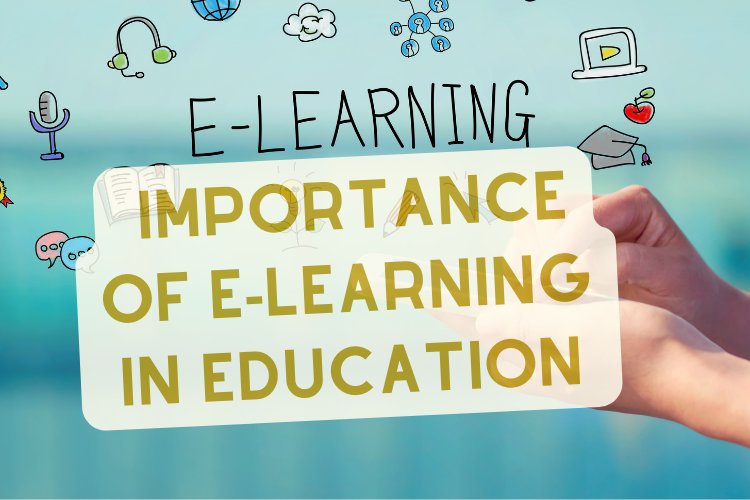What is E-learning & how it's Important to Education System?
What is E-learning and know the importance of eLearning in education, Importance of E Learning , Benefits Of eLearning For Students

What is E-learning & how it's Important to Education System?
E-Learning includes instruction that can take place in or out of the classroom, as well as the use of computers and the Internet. E-learning is defined as offering training and development to students/employees via electronic media such as the Internet, audio, video, and so on.
E-learning, often known as electronic learning or virtual learning, refers to web-based learning. People nowadays search for answers to their questions on the internet rather than in books or by asking someone. As a result, the Importance of E-Learning in Education has grown.
There are interactive classes and courses on many topics, programs, and degrees that are provided entirely online. Emails, live lectures, and video conferencing are just a few of the channels that allow participants to express their opinions on a specific topic and then discuss it further.

There is a great opportunity to discuss various topics via video conferencing or live chat. Static pages, such as course materials, are also made available for the benefit of all participants. It is worth seeing what exactly is the informed or derived platform of knowledge established by e-learning and its many elements.
Meaning and Concept of e-learning
E-Learning is the process of imparting knowledge via numerous media such as e-books, CDs, webinars, and others. It has transformed the traditional way of teaching students using chalk and board.
E-Learning education, on the other hand, makes providing and receiving easier, more prolific, more productive. Tutors use the most up-to-date technology to teach students.
E-Learning is defined as courses that are expressly given via the internet in locations other than the typical classroom where the teacher is lecturing. The utilization of the internet, technology, and gained knowledge and skills is referred to as e-learning.
As a result, both teaching and learning become simpler, easier, and more successful The terms e-learning and web-based training or online tutoring are interchangeable. The phrase "e-learning" can be used in a variety of ways, but the premise stays the same. It has altered traditional school teaching practices.

Importance of e-learning
- E-learning has been created to enable learners to obtain basic schooling and improve their skills. They can also earn a degree certificate without ever visiting a school, university, or other institution.
- It is a terrific source of income for tutors because they may teach from anywhere at any time.
- Using e-learning at all levels of education helps to ensure that students grasped the teachings effectively and quickly.
- The audio-visual approach of teaching, according to psychology, results in a disciplined learning environment. Effective tutor and student engagements exist.
- One of the benefits of e-learning in school is that both tutors and students can develop advanced learning skills. One such breakthrough is the creation and sale of eBooks.
- E-learning has worked to bring together learners, tutors, experts, practitioners, and other interest groups. As a result, there is a good practice of knowledge exchange practiced through various online venues. This is critical in today's environment, where competition is increasing and the world is expanding. As a result, rapid knowledge aids in an individual's development.
Types of eLearning or e-Education
Digital and self-directed education can be obtained at the desired settings. E-learning education is adaptable and well-equipped to accommodate all learning techniques, so one need not roam in quest of education.
E-Learning is accomplished in a variety of ways and is often a combination of the following approaches and practices:
- Completed online with no in-person meetings
- Mixed Learning - A combination of online and direct communication
That is in the two different forms
- The communication between the sender and receiver occurs simultaneously, as in chat rooms or video-audio conferencing.
- Information is transmitted asynchronously via forums, emails, wikis, etc.
- It is also promoted by self-study practices.
- Web-based education is another superior alternative
- CD-ROMs offer subject-specific depth of knowledge
- Audio and visuals are complementary, descriptive, and communicative modes of expression.

Benefits of E-Learning in Education
An analysis of the advantages of online learning will prompt us to consider how teachers, students, and institutions seek to obtain relevant and easily accessible content in the present day.
With the online style of education, students can study at their convenience and according to their needs. Also, teachers have a great deal more instructional flexibility.
The following are some of the benefits of e-learning that you should not miss.
- Online Education is adaptable to everyone's requirements.
- Classes can be taken from any location and at any time that the tutor or student choose.
- It provides access to content that is exclusive, abundant, and up-to-date, and its accessibility is open, secure, and uninterrupted.
- E-Learning enables you to keep up with modern learners and current trends.
- It ensures timely delivery of lessons. Traditional classrooms entail a delay of some sort. eLearning facilitates the rapid and exclusive distribution of lessons. There are no delayers in eLearning. It is a rapid method of learning!
- Measuring the scalability of learning, content, and course duration is feasible. It is good for those who experience anxiety and isolation in groups. It facilitates learning without requiring the sacrifice of a comfortable atmosphere. You are comfortable with Consistency in exposure, inputs, outcomes, and coordination is highly valued in E-Learning because it enables teachers to offer the curriculum on a regular basis with a greater degree of coverage. This ensures learning consistency.
- The process is made far more affordable. The significance of E-Learning education is that it is rapid and inexpensive. Reduce the lengthy training period, infrastructure, stationery, and travel expenses, etc.
- The transferred or taught knowledge and learning are highly effective and potent. It facilitates information comprehension and retention. The Audio-Visuals aid in the long-term retention of information. In addition, the courses prepared by teachers are well-organized.
- Mobility guaranteed is a very convenient and inexpensive choice. In conventional classes, it is difficult to engage in review and gain practical experience with many subjects. In contrast, missed lessons can always be repeated online. This facilitates tutors' ability to deliver the correct information.
- It encourages an independent learning process.
Students can create a self-paced training schedule using e-learning. Also, the tutoring process becomes much simpler. People who work 9 to 7 or simply lack the time to participate in physical classes are no longer left behind. They can participate in online sessions after work, on the weekends, or whenever they have free time.
They only require an internet connection, a computer or laptop, microphones, and headphones. E-Learning has numerous applications and aids students in their education.
- Tutors have a range of teaching options, including creating recorded lessons, hosting brief webinars, and selling courses in annual packages. Thus, there are several opportunities for generating a secondary or even a primary income.

Benefits of E-Learning For Students
Unlike the traditional way of teaching using a board and chalk, E-learning is accomplished through online learning, which allows students to learn at their own pace and convenience.
Let's have a look at the benefits of E-Learning for students:
- You have unlimited access to the study material.
- You can study your Courses whenever and wherever you choose.
- When students desire, they can access updated content.
- Unlike traditional instructional methods, e-learning provides a rapid form of delivery. This means that the amount of time spent learning has been lowered.
- E-Learning allows for scalability, which aids in training delivery.
- All students can access the same curriculum, study materials, and training via E-Learning.
- You can save time, money, and traveling expenditures by using E-Learning. As a result, E-Learning is less expensive than traditional learning.
- E-learning is delivered online, eliminating the need for paper-based learning. As a result, we can conserve the environment by doing so.
One can link the various resources in several varying formats.
- Web-based learning encourages active and self-directed learning.
- Elearning education can benefit college students, full-time workers, homeowners, YouTubers, and coaching institutes.
- One of the most significant advantages of the internet or e-learning is the ability to educate oneself from the comfort of one's own home and obtain a degree.

These impossibilities are only made conceivable by technological advancements
- Another advantage of eLearning is its convenience and flexibility. All of the resources for students and teachers are available in one location.
- On a daily basis, anyone can receive training. It can take place on weekends or whenever there is free time.
- E-learning is also advantageous in the corporate world. This is due to the fact that staff should be taught on new skills as well. It aids in their efficiency and is beneficial to their future schooling course of time.
- Discussion boards or chat boxes are an easy approach to clear up any confusion. Tutors can simply answer students' questions. As a result, interaction improves.
- Global education- Tutors can deliver online education in several languages and across time zones.
- Last but not least, eLearning is good for the environment because paperless education has helped to save many trees. Tutors also think this option is wonderful because each student's evaluation is now done online, which is faster and less tiring.
- E-Learning has become a valuable resource for tutors all around the world. Previously, not everyone had equal access to knowledge. Geographical boundaries had made travel to other countries impossible for instructors and pupils. This new tendency has aided in the delivery of constant education.
- E-learning also provides learners and teachers with broader collaboration and worldwide opportunities.
We know that online learning is expanding and will continue to increase exponentially in the future.












